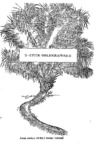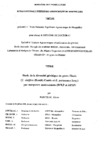Use este identificador para citar ou linkar para este item:
http://www.alice.cnptia.embrapa.br/alice/handle/doc/666838| Título: | Etude de la diversité génétique du genre Elaeis (E. oleifera (Kunth) Cortés et E. guineensis Jacq.) par marqueurs moléculaires (RFLP et AFLP). |
| Autoria: | BARCELOS, E.  |
| Afiliação: | Embrapa Amazônia Ocidental. |
| Ano de publicação: | 1998 |
| Referência: | 1998. |
| Páginas: | 136 f. il. |
| Conteúdo: | Genetic diversity and its organization within oil palm E. oleifera and E. guineensis germplasm were evaluated by using molecular markers. Restriction fragment length polymorphism RFLP genetic variability was revealed with 37 nuclear cDNA, 1 rDNA, 2 chloroplastic and 4 mitochondrial probes over 241 accessions of the American species E. oleifera from Brazil, Peru, North of Colombia, Central America, French Guyana and Surinam and 38 accessions of African species E. guineensis from Angola, Cote d'Ivoire, Cameroun, Zaire, Benin, Nigeria, and Deli and Brazil/Bahia introduced origins. These accessions cover a large part of the geographical distribution areas of these species on the American and African continents, respectively. Amplified fragment length polymorphism AFLP technique was performed on a sub-set of 44 accessions of E. oleifera and 22 accessions of E. guineensis by using three pairs of enzyme/primer combinations. Nuclear DNA content variation was assessed by flow cytometry. Data were subjected to factorial analysis of correspondence, cluster analysis and population F-statistics genetic analysis. Results appeared very congruent between RFLP and AFLP, with both type of markers revealing that genetic divergence between the two species is surprisingly of the same magnitude as in the E. oleifera species alone, this finding being in discrepancy with the early Tertiary separation of the two species. At the E. oleifera species level, a strong structuring of genetic diversity was revealed according to the geographical origin of the studied material, with the identification of four distinct genetic groups, Brazil, Peru, Central America and French Guyana/Surinam, with 74% of total variability being due to the difference among these groups. The genetic structuring revealed within E. oleifera origins from Brazilian Amazon region is in agreement with the fluvial network of this region, with 35% of the overall variability within 32 studied populations being due to difference between these populations. The Elaeis cytoplasmic genome revealed a low genetic diversity with only two types of chloroplast for the whole genera, one of this types being common to the two species while the other type eas specific to the E. oleifera accessions originated from Central Amarica. The mitochondrial genome analysis revealed six mitochondrial types in the American species and two in the African species (4.03+-0.11 pg) with accessions from Surinam presenting the lower quantity. The African species presents the same DNA quanty as Surinam accessions. Within this genus, genetic diversity organization and evolution was discussed and consequences on oil palm genetics resources management and utilization were addressed. |
| Thesagro: | Dendê Elaeis Guineensis Elaeis Oleifera Isoenzima População de Planta Variação Genética |
| NAL Thesaurus: | genetic variation |
| Palavras-chave: | Plant population Isoenzymes |
| Notas: | Thèse (Diplôme de Doctorat) - Ecole Nationale Supérieure Agronomique de Montpellier, Montpellier. |
| Tipo do material: | Teses |
| Acesso: | openAccess |
| Aparece nas coleções: | Tese/dissertação (CPAA)  |
Arquivos associados a este item:
| Arquivo | Descrição | Tamanho | Formato | |
|---|---|---|---|---|
| TsEdson002.pdf | 5,4 MB | Adobe PDF |  Visualizar/Abrir | |
| TsEdson001.pdf | 1,9 MB | Adobe PDF |  Visualizar/Abrir |









